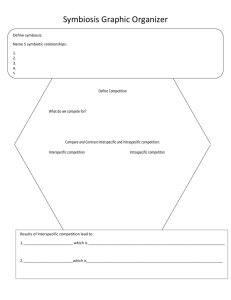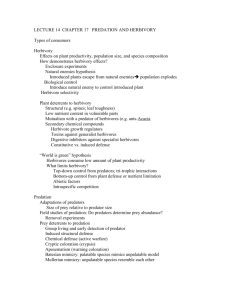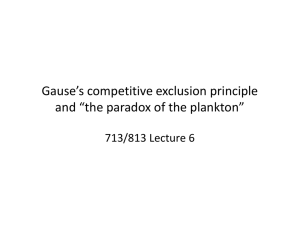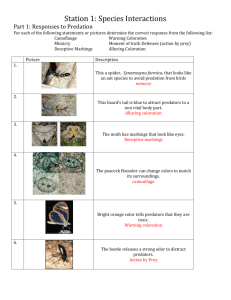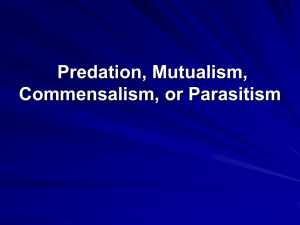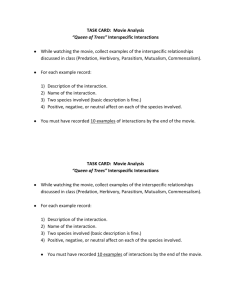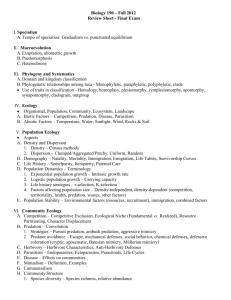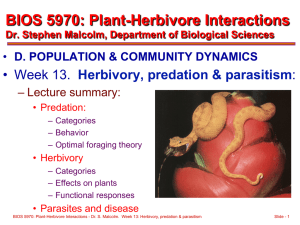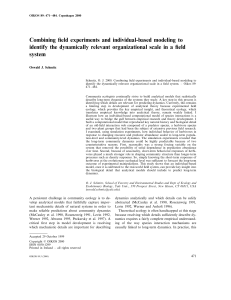11/7 - Fairfield Faculty
advertisement
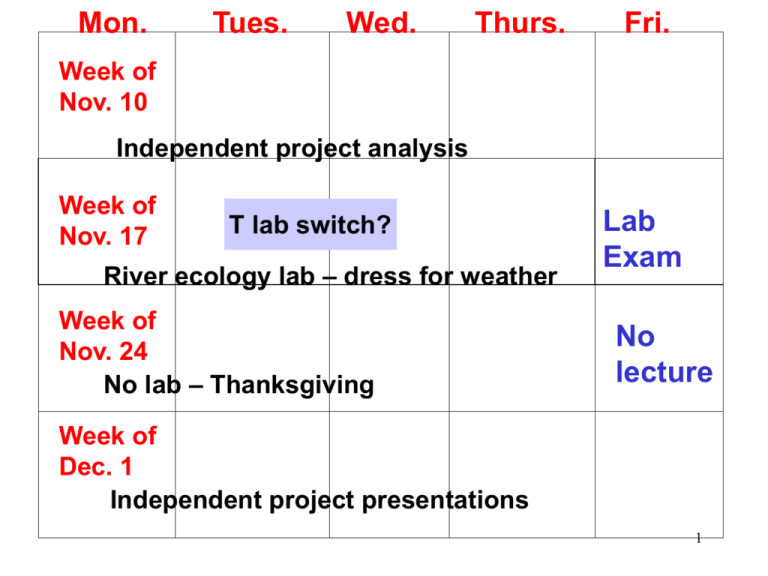
Mon. Tues. Wed. Thurs. Fri. Week of Nov. 10 Independent project analysis Week of Nov. 17 T lab switch? River ecology lab – dress for weather Week of Nov. 24 No lab – Thanksgiving Lab Exam No lecture Week of Dec. 1 Independent project presentations 1 Structure of course Environmental variability Organisms Ecosystems Populations Species interactions Communities Applied Ecological Issues 2 Consumer/resource interactions 1. Predation 2. Herbivory 3. Parasitism 4. Dynamics of C/R interactions 3 Why don’t herbivores drive plants extinct? Or Why is the world green? 1. Plant defense - physical - chemical 2. Plants can hide too 3. Herbivores have predators 4 Constitutive defense 5 Figure 17.16 Induced defense 6 Why don’t herbivores drive plants extinct? Or Why is the world green? 1. Plant defense 2. Plants can hide too 3. Herbivores have predators 7 Spatial refuge Figure 17.1 8 Index of cone production Production of population not individuals Cost 9 Why don’t herbivores drive plants extinct? Or Why is the world green? 1. Plant defense 2. Plants can hide too 3. Herbivores have predators 10 Predator Herbivore Algae 11 Consumer/resource interactions 1. Predation 2. Herbivory 3. Parasitism 4. Dynamics of C/R interactions 12 How is a parasite different from a predator? 13 Parasites are incredibly diverse Examples? 14 15 Challenges for a parasite 16 Figure 17.14 17 pillbug = intermediate host tapeworm in a crow tapeworm changes pillbug behavior 18 Consumer/resource interactions 1. Predation 2. Herbivory 3. Parasitism 4. Dynamics of C/R interactions 19 Dynamics of consumer/resource interactions Consumers can reduce resource populations Examples of cycles Models of consumer/resource interactions 20 Figure 17.18 Effect on growth rate 21 22 Dynamics of consumer/resource interactions Consumers can reduce resource populations Examples of cycles Models of consumer/resource interactions 23 Figure 18.4 Cause of cycle? size of measles population 24 Figure 18.2 25 Lynx - + Hare 26 Dynamics of consumer/resource interactions Consumers can reduce resource populations Examples of cycles Models of consumer/resource interactions - math helps understand mechanisms 27 For prey (R): dR/dt = rR – predation For predators (P): dP/dt = rate at which prey are converted to new predators – death of predators 28 Species interactions Introduction Consumer/resources interactions (predation, herbivory, parasitism) Competition Mutualism 29 Interspecific Competition Introduction Competitive exclusion How do species coexist? 30 Competitive interactions A B 31 What are some resources that organisms compete for? 32 Intraspecific competition – competition between individuals of the same species Interspecific competition – competition between individuals of different species 33 Two methods of competition Interference competition Exploitation competition 34 Figure 19.13 Exploitation Interference 35 Intraspecific interference competition Intraspecific exploitation competition Interspecific exploitation competition 36 Competition may be asymmetric - A B 37 Figure 19.11 A B 38 Species A has a bigger effect on B than B has on A How would you draw this? A B 39 Which one of the following is not an example of competition between species? a. Blowflies and fleshflies breed in the same types of carcasses, and both species experience reduced reproduction rates when densities within carcasses are high. b. Sage plants produce a ring of bare ground surrounding them. c. Wolverines and mountain lions fight each other for deer carcasses. d. Spotted owls and great horned owls occupy the same type of habitat. 40 Competition Introduction Competitive exclusion How do species coexist? 41 Figure 19.6 42 Figure 19.2 43 Competitive exclusion principle: two species that use the same limiting resource in the same way cannot coexist Limiting resource – a resource which is scarce relative to the demand for it 44 Competitive exclusion is difficult to witness outside of laboratory experiments Why?? 45 Figure 19.10 parasitoids – all use resource same way 46 Competition Introduction Competitive exclusion How do species coexist? 47 How do species coexist? 1. Resource partitioning 2. Predation on one or more species 48 How do species coexist? 1. Resource partitioning -different species aren’t using the same resource exactly the same way 49 Eats small to medium seeds Eats medium to big seeds 50 5 warbler species all eat insects in spruce trees . . . . . 51 How do species coexist? 2. Predation on one or more species 52 A B - 53 Consumer + - A B - 54 Bob Paine experiments Mussel = dominant competitor 55
